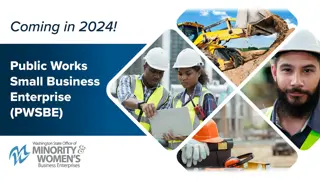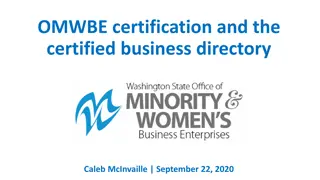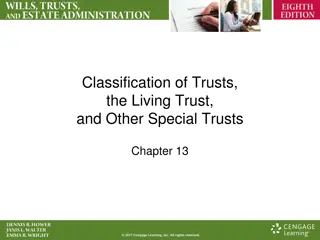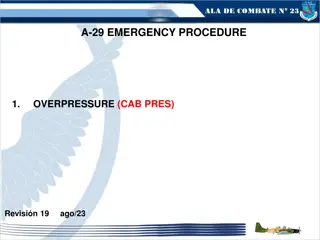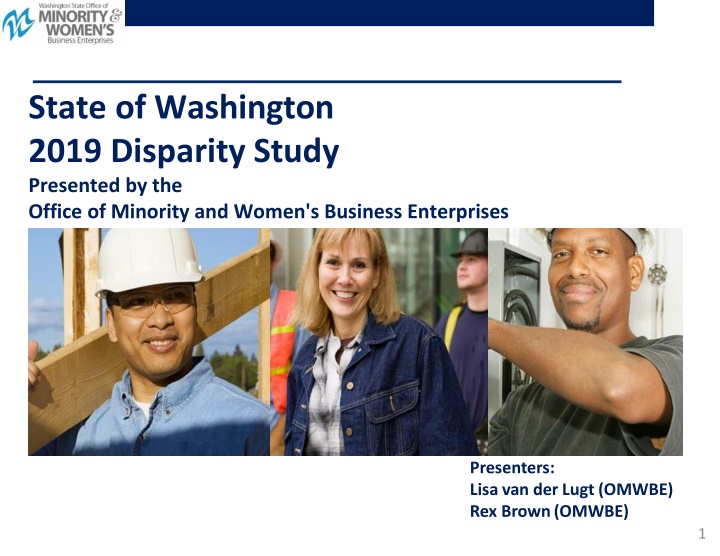
Washington State Office of Minority and Women's Business Enterprises - Empowering Diversity in Business
Learn about the Washington State Office of Minority and Women's Business Enterprises (OMWBE), its mission to promote equal participation by minority- and women-owned businesses, and its various initiatives to support supplier diversity, certification, and more.
Download Presentation

Please find below an Image/Link to download the presentation.
The content on the website is provided AS IS for your information and personal use only. It may not be sold, licensed, or shared on other websites without obtaining consent from the author. If you encounter any issues during the download, it is possible that the publisher has removed the file from their server.
You are allowed to download the files provided on this website for personal or commercial use, subject to the condition that they are used lawfully. All files are the property of their respective owners.
The content on the website is provided AS IS for your information and personal use only. It may not be sold, licensed, or shared on other websites without obtaining consent from the author.
E N D
Presentation Transcript
State of Washington 2019 Disparity Study Presented by the Office of Minority and Women's Business Enterprises Presenters: Lisa van der Lugt (OMWBE) Rex Brown(OMWBE) 1
ContactInformation: Lisa van der Lugt, Director Washington State Office of Minority & Women s Business Enterprises Office:360-664-9757 Cell: 360-528-0514 Lisav@OMWBE.WA.GOV Rex Brown, AssistantDirector- Governor s Subcabinet on Business Diversity Washington State Office of Minority & Women s Business Enterprises Office:360-664-9769 Cell:360-561-7261 RexB@OMWBE.WA.GOV 2
Why does OMWBEexist? Our charge: Identify and eliminate barriersto equal participation by minority- and women-owned businesses in contracts with state agencies and educational institutions. History of OMWBE OMWBE was created in 1983 by the state legislature. OMWBE is governed by RCW 39.19, which states: The purpose and intent of this chapter are to provide the maximum practicable opportunity for increased participation by minority and women-owned and controlled businesses in participating in public works and the process by which goods and services are procured by state agencies and educational institutions from the privatesector. 3
WhatdoesOMWBE do? Leads Governor s Subcabinet on Business Diversity. Certification: State s sole certifying agency for small businesses owned and controlled by minority, women, and socially and economically disadvantaged persons. Supplier Diversity: Works with state and local agencies to improve supplier diversity in state contracting. 4
What else OMWBE does . . . Linked Deposit: We coordinate the Linked Deposit Loan Program with Washington State Department of Veterans Affairs and Office of State Treasurer. Tracking and Reporting: We track and report diverse spending by state agencies. Partnerships: We partner with other agencies and organizations to educate businesses on the certification and public procurement process. 5
Statutory Authority OMWBE is to provide the maximum practicable opportunity for increased participation by minority and women-owned and controlled businesses in participating in public works and the process by which goods and services are procured by state agencies and educational institutions from the private sector. - RCW 39.19.010 The State of Washington intends to develop procurement policies, procedures, and materials that encourage and facilitate state agency purchase of goods and services from Washington small businesses. - RCW 39.26.005 6
What is a Disparity Study? A disparity study is an analysis that examines the number of specified individuals or groups who are available to obtain contracts, and those who are actually selected (utilized). The 2019 WA study looked at goods and services, client services and public works contracting and purchasing. 8
Utilization and Availability Determine utilization as a percent of total dollars in the agencies geographic and product marketplaces o 75% sample Determine the availability as a percent of all firms. Calculate disparity indices for contracts: o All race & sex groups & all industry groups combined & disaggregated. o Examine various impacts by industry & North American Industry Classification System (NAICS) codes. 8
Disparity Ratios Disparity ratio = M/WBE utilization availability 9
Washington State Utilization Analysis Washington State Availability Analysis Study collected data and analyzed state utilization of MWBEs (all funded contracts for FFY sectors & all agencies from 2012 to 2016) MWBE aggregated weighted availability (all sectors and agencies combined) Race/Gender Populations Percent of Population Dollars Distributed to Population Final Data Contract file =$3,484,653,357 613 prime contracts (74.5%) =$2,596,300,922 MWBEs 15.2% $444,050,244.54 Blacks 1.7% $35,084,771.45 Hispanic 0.7% $16,473,011.36 2,690 subcontractor contracts (25.5%) =$888,352,435 Asians 2.6% $21,385,445.52 Native Americans 0.6% $49,726,396.15 White Females 9.6% $321,380,620.06 Non MWBEs 84.8% 2,413,069,446.62 10
What does the Disparity Study say? Race/Gender Disparity Ratios (all sectors & agencies combined) Disparity Ratios (without Client Services) Disparity Ratios (without Client Services & NAICS 238210) 71.3%* + + 54.43%*** + + MWBEs: 102.4% 2.5% + + 2.52% + + 70.4% + + Blacks: Hispanics: 86.8% 110.1% 85.87% 29.9% + + 30.37% + + 29.3% + + Asians: Native Americans: 294.5% 310.3% 322.35% 79.8% + + 53.05% + + White females: 116.8% 105.3%*** 109.02%*** Non-MWBEs: 99.6% Below 80%? *** Indicates statistical significance at the 0.001 level * Indicates statistical significance at the 0.05 level + + Indicates substantivesignificance(under 80%) 11
Statewide DisparityAnalysis Survey of BusinessOwners: o Very large disparities in firms sales receipts between M/WBEs &Non-M/WBEs American CommunitySurvey: o In most cases, M/WBEs were underutilized relative to White men. o Wages & business earnings were lower for these groups compared to Whitemen. 12
Key AnecdotalData Reported Most M/WBEs reported that it is extremely difficult to obtain work on State projects. M/WBE certification conferred fewbenefits. Long established firms recounted the negative impact of Initiative200. Small firms found it difficult to access contracting information. Contracts were often too large for small firms. Insurance, bonding, experience requirements, etc., are barriers. Antiquated & decentralized state systems are challenges. 13
Disparity StudyRecommendations Implement an electronic data collection & monitoring system. Examine current policies & provide best practices. Conduct pre-bid conferences. Post winning bidders/proposers to WEBS. Conduct additional outreach efforts: o Conduct special outreach to M/WBEs in industries where they have received few opportunities. o Focus outreach on agencies with low M/WBE utilization. Increase technical assistance to M/WBEs & small firms. Lengthen solicitation times. (cont d) 14
Disparity StudyRecommendations Review contract sizes & scopes. Raise the Direct Buy limits. Adopt quick pay policies. Review insurance, surety bonding & experiences requirements. Train state staff on how to increase diversity in contracting. Develop race- & gender-neutral programs like: o Bonding & financing support o Target Market program o Mentor-prot g program, etc. Develop performance measures for success. 15
Path forward: The Governors Subcabinet on Business Diversity What is it? Governor Jay Inslee chose 12 of his executive cabinet agencies for the Subcabinet. These agencies make up 2/3 of the total state spend with key partner agencies (see roadmap). While the problem is too broad and complex for a quick fix, the subcabinet has identified a clear and strategic path to achieve durable and sustainable changes. 16
Roadmap to Contracting Equity Governing Body Governor s Subcabinet on Business Diversity Attorney General s Legal Opinion (No. 2017-02) Disparity Study Standardize Race and Gender Neutral Measures* Evaluate Race and Gender NeutralMeasures YES, IT S WORKING NO, IT S NOT OR Continue Race and Gender NeutralMeasures Confirm Race and Gender Neutral Measures not sufficient Consider Race and Gender Conscious Measures * Among agencies - policy, procedures, measures, training,adjustments. Subcabinet agencies and partners: Department of Enterprise Services Department of Social and Health Services Department of Transportation Health Care Authority Department of Corrections Department of Labor and Industries (Represent 2/3 of state spending) Office of Minority and Women s Business Enterprises * Department of Veteran Affairs Commission on African American Affairs Commission on Asian Pacific American Affairs Commission on Hispanic Affairs Governor s Office for Regulatory Innovation and Assistance Attorney General s Office 17 19-02-0081
The path to standardizing race and gender neutral measures among agencies Community of Practice The Community of Practice (CoP) provides support for agencies including resources such as model polices, tools and best practices as well as training support Piloting: Six agencies representing 2/3 of state spending* Existing CoP Toolbox Current Voluntary Measures Improved agency guidance and support voluntary goals Established model contractlanguage Created guidance on targeted community engagement and outreach Merged statewide small business information for easieraccess Updated and mergedresources for technical assistance InProgress Establish nine model policies Provide guidance on supplier diversity training options and best practices Check, adjust and expand CoP toolbox Establish internal agency culture action team Utilize state s data sources to help inform supplier diversity efforts Additional agencies join the CoP Improve methodology for tracking and monitoring good faith efforts Include diverse spending data from purchasecards Conduct proof of concept; measuring participation in client services and provider contracts Check, adjust and expand toolbox Improved certification process Utilized inclusion plans in public works contracting Subcabinet agencies and partners WashingtonState DEPARTMENT OF SOCIAL HEALTH SERVICES *Represent 2/3 of state spending 18
Areas of Focus Community of Practice(CoP) Measurement Framework Improved Certification TechnicalAssistance Legal Framework provides the foundation AGO Opinion DisparityStudy 19
Detailed Action Plan: Partners DSHS, DOC Task Task Lead OMWBE, LNI Expected Outcome Create suite of measures to provide the best dashboard for accountability and improving results. Increase use and reliability of data. Conduct rulemaking to reduce unnecessary barriers and improve certification timeframes. Status Ongoing Due Date Completed January 2018 Measurement Framework Improved OMWBE Certification OMWBE Ongoing Completed January 2018 Community of Practice (CoP) Embed a broad understanding of equity, diversity and inclusion throughout community of procurement professionals. DSHS, WSDOT, DES, OMWBE HCA Ongoing Launched February 2018 ORIA, Commerce Create a system for small business to customize their needs to available resources. Central web site with triage services. Feedback loop for quality control. Technical Assistance OMWBE, DES Ongoing Launched October 2018 Disparity Study Provide necessary data needed to understand whether minority-, women- and veteran-owned businesses have equal access to contracting opportunities. DES 31 State Agencies and 2 Educational Institutions Ongoing Completed 6/19/2019 20
Questions andAnswers ThankYou! 21



